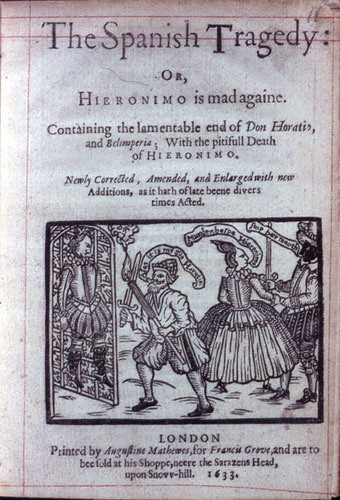Thomas Kyd, author of The Spanish Tragedy @550
The Spanish tragedy: or, Hieronimo is mad againe: Containing the lamentable end of Don Horatio, and Belimperia; with the pitifull death of Hieronimo
Publisher: London : Printed by Augustine Mathewes, for Francis Grove, and are to bee sold at his shoppe, neere the Sarazens Head, upon Snovv-hill, 1633.
When one researches the history of horror[1], one encounters the revenge tragedy in the 16th century, featured because of the genre’s cruelty. In the 1580s, an incredible series of gruesome revenge plays were performed on the stages of England.
An example of the gruesomeness of these plays:
“Enter the empress’s sons with Lavinia, her hands cut off, and her tongue cut out, and ravished.” —stage direction to Shakespeare‘s Titus Andronicus. (Chiron and Demetrius had taken Lavinia away and raped her over her husband’s body. To keep her from revealing what she has seen and endured, they had cut out her tongue and cut off her hands.)
The Spanish Tragedy (d. 1594) by Thomas Kyd is exemplary and one of the earliest items in the history of the revenge play.
The play is also noted for being an early instance of the metatheatre (play-in-play) trope. Aditionally, Thomas Kyd is also an icon in the history of counterculture (he was put on the rack for allegations of heresy).
The history of horror is an interesting subject because of its ontological and temporal issues. It starts with horror fiction and horror art and ends at the commodified terrain of the horror film and gothic fashion.
Most recently the concept of horror was explored by Collapse journal volume 4.

